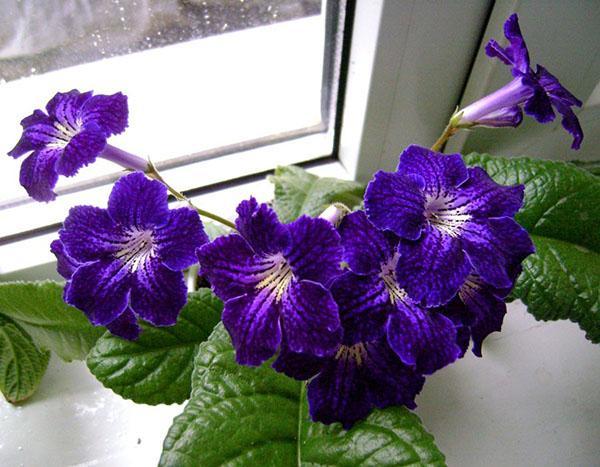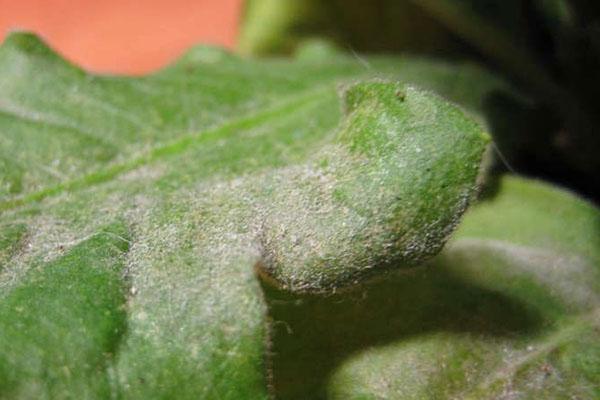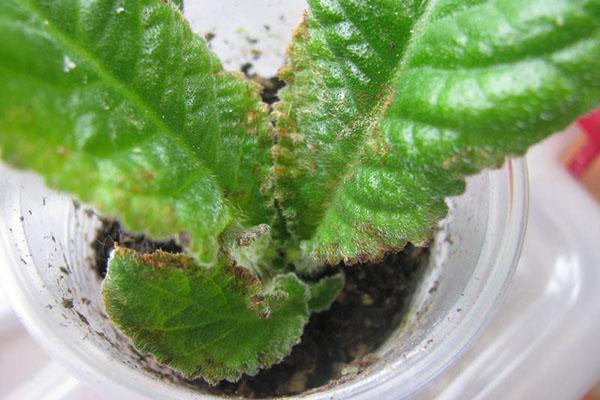Diseases of streptocarpus and effective ways to combat
 All diseases of streptocarpus that exist are the result of improper care. Therefore, in order for the plant to always be beautiful and healthy, the basic recommendations must be followed.
All diseases of streptocarpus that exist are the result of improper care. Therefore, in order for the plant to always be beautiful and healthy, the basic recommendations must be followed.
Streptocarpus diseases and the best methods of dealing with them
To help your beloved flower, you need to know what diseases can affect it, how they look and respond in a timely manner to the problem that appears.
Powdery mildew

Controlling powdery mildew:
- Initially, you will need to remove all affected leaves. Cut them off with a sharp tool.
- Then remove the top layer of soil from the flowerpot and replace it with a new one.
- The final step is to treat the entire plant with an antifungal agent. It helps best with powdery mildew Fitosporin, Baktofit. You can also use Topaz, Speed.
Brown bloom on the leaves
 The so-called rust appears as yellow spots. A lot of moisture or planting density can lead to this. Less often, plaque appears due to an excess amount of fertilizer, which contains nitrogen.
The so-called rust appears as yellow spots. A lot of moisture or planting density can lead to this. Less often, plaque appears due to an excess amount of fertilizer, which contains nitrogen.
In the early stages, getting rid of rust is easy. To do this, you just need to remove the affected shoots and leaves.
If the entire bush is covered with a red bloom, then you need to use fungicides. A good option is to use Baktofit.
Yellowing and drying of leaves
 Many do not know why the leaves of streptocarpus dry. In fact, the main reason for this behavior of the plant is too dry air or due to the lack of ventilation of the room.
Many do not know why the leaves of streptocarpus dry. In fact, the main reason for this behavior of the plant is too dry air or due to the lack of ventilation of the room.
If the leaves on the sides begin to dry, then they will need to be completely removed. Then water the plant abundantly and place a container with liquid near the flowerpot. An electric humidifier will work well.
If you make optimal conditions for the flower, then the problem of drying leaves will not happen again.
Gray rot
 This is a fungus that infects leaves and stems. Less often, gray rot manifests itself on the root system of streptocarpus. It spreads through the air and soil. Also, the fungus can be transmitted through infected plants. You can identify gray rot by brown spots, which grow rather quickly.
This is a fungus that infects leaves and stems. Less often, gray rot manifests itself on the root system of streptocarpus. It spreads through the air and soil. Also, the fungus can be transmitted through infected plants. You can identify gray rot by brown spots, which grow rather quickly.
You can restore the original appearance of the bush by replacing the soil and flowerpot, as well as by treating the plant with a fungicide.
It is best to fight gray rot with preparations that contain copper.
Streptocarpus pests
Houseplants are often attacked by various insects. Timely assistance to the plant will help preserve it and wait for lush flowering.
Thrips
 These insects most often affect the leaves of streptocarpus. It is almost impossible to see them. Identified by brown, dried anthers. Plants that are affected by insects quickly fade, and pollen spills are visible on the petals.
These insects most often affect the leaves of streptocarpus. It is almost impossible to see them. Identified by brown, dried anthers. Plants that are affected by insects quickly fade, and pollen spills are visible on the petals.
Stages of thrips control:
- remove all buds and flowers on the bush;
- spray the plant with Acarin, combined with flea shampoo;
- you need to process the resulting solution every week.
Also, do not forget about the optimal indicators of indoor air humidity and temperature.
Spider mite
 This is a dangerous insect that carries infectious diseases of indoor plants. See spider mite can be on the bottom of the leaf between the veins. An oily sheen appears in these places. If nothing is done, the leaf will turn yellow and dry after a short time. Getting rid of a tick is quite problematic. It cannot be removed with ordinary insecticides. It is best to use modern drugs in this case.
This is a dangerous insect that carries infectious diseases of indoor plants. See spider mite can be on the bottom of the leaf between the veins. An oily sheen appears in these places. If nothing is done, the leaf will turn yellow and dry after a short time. Getting rid of a tick is quite problematic. It cannot be removed with ordinary insecticides. It is best to use modern drugs in this case.
Apollo and Sunmite are effective in the fight against spider mites. You need to use the product according to the specified instructions.
Aphid
 The signs are twisted leaves with lots of white aphid shells. This insect appears, most often, due to improper irrigation. You can get rid of the pest with both purchased and home remedies.
The signs are twisted leaves with lots of white aphid shells. This insect appears, most often, due to improper irrigation. You can get rid of the pest with both purchased and home remedies.
You can collect aphids on leaves and stems using a soapy solution.
An infusion of 15 g of onion and 1 liter of water helps a lot. The components must be combined in one container, mixed thoroughly and infused for 7 hours. Also an excellent option for aphids is citrus peel infusion. To do this, you need to take 100 g of crusts and 1 liter of clean, warm water. You need to insist such a remedy at room temperature for a day.
Knowing what diseases are streptocarpus, you can quickly cure the flower and continue to enjoy its flowering. But in order not to lead to the appearance of insects and the development of fungi, infections, you should follow simple rules for caring for the plant. After all, it is from the discrepancy in the amount of moisture that the flower can change its color.